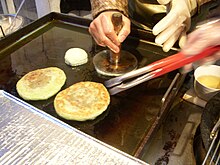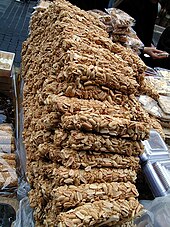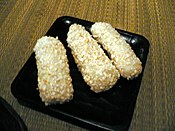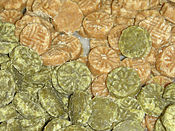
This is a list of Korean desserts. Korean cuisine known today has evolved through centuries of social and political change. Originating from ancient agricultural and nomadic traditions in southern Manchuria and the Korean peninsula, Korean cuisine has evolved through a complex interaction of the natural environment and different cultural trends.
Korean desserts
| Name | Image | Description |
|---|---|---|
| Bungeo-ppang | 
|
A fish-shaped pastry stuffed with sweetened red bean paste, which originated from the Japanese taiyaki. |
| Chapssal-tteok | 
|
A tteok, or Korean rice cake, made of glutinous rice. |
| Hwangnam-ppang | 
|
A small pastry with a filling of red bean paste. |
| Hodu-gwaja | 
|
A walnut-shaped baked confection with red bean paste filling, whose outer dough is made of skinned and pounded walnuts and wheat flour. |
| Hoppang | A convenience food version of jjinppang (steamed bread) and is typically filled with smooth, sweetened red bean paste. | |
| Hotteok | 
|
A variety of filled Korean pancake, and is a popular street food of South Korea. |
| Kkul-tarae | 
|
Composed of fine strands of honey and maltose, often with a sweet nut filling. |
| Melona | 
|
An ice pop. There are various flavours such as honeydew melon, banana, mango, strawberry, coconut and purple yam. |
| Patbingsu | 
|
A shaved ice dessert with sweet toppings that may include chopped fruit, condensed milk, fruit syrup, and red beans. Varieties with ingredients other than red beans are called bingsu. |
Hangwa

Hangwa is a general term for Korean traditional confectionery. Common ingredients in hangwa are grain flour, honey, yeot, sugar, fruit or edible root.
- Dasik
- Gangjeong
- Gwapyeon
- Jeonggwa
- Maejakgwa
- Mandugwa
- Okchun-dang
- Suksilgwa
- Yakgwa
- Yeot
- Yeot-gangjeong
- Yumilgwa
-
 Dasik, a variety of hangwa, is made from nongmal (which is starch made from potatoes, sweet potatoes or soaked mung beans), pine pollen singamchae, black sesame, honey, flour from rice or other grains, nuts and/or herbs.
Dasik, a variety of hangwa, is made from nongmal (which is starch made from potatoes, sweet potatoes or soaked mung beans), pine pollen singamchae, black sesame, honey, flour from rice or other grains, nuts and/or herbs.
-
 Yumilgwa made by deep frying a mixture of grain flour and honey.
Yumilgwa made by deep frying a mixture of grain flour and honey.
Tteok


Tteok is a class of Korean rice cakes made with glutinous rice flour (also known as sweet rice or chapssal), by steaming.
- Baek-seolgi
- Gaepi-tteok
- Bupyeon
- Danja
- Hwajeon
- Injeolmi
- Jeolpyeon
- Jeungpyeon
- Mujigae tteok
- Sirutteok
- Songpyeon
- Tteokbokki
- Tteokguk
- Yaksik
-
 Bupyeon, with mujigae tteok at top. Bupyeon are doughs of glutinous rice flour and a sweet filling and covered with gomul (powdered beans).
Bupyeon, with mujigae tteok at top. Bupyeon are doughs of glutinous rice flour and a sweet filling and covered with gomul (powdered beans).
-
 Jeolpyeon is prepared with rice powder dough which is steamed and patterned.
Jeolpyeon is prepared with rice powder dough which is steamed and patterned.
-
 Songpyeon are small rice cakes traditionally eaten during the Korean autumn harvest festival, Chuseok.
Songpyeon are small rice cakes traditionally eaten during the Korean autumn harvest festival, Chuseok.

See also
Korean desserts
Related topics
- Cuisine
- Korean baked goods
- Korean snacks (category)
- List of desserts
- List of Korean beverages
- List of North Korean dishes
References
- "Korean Cuisine (한국요리 韓國料理)" (in Korean). Naver / Doosan Encyclopedia. Retrieved 2009-03-28.
- "chapssal-tteok" 찹쌀떡. Standard Korean Language Dictionary (in Korean). National Institute of Korean Language. Retrieved 20 May 2017.
- Lee, Robyn (June 5, 2009). "Snapshots from South Korea: Patbingsu, a Popular Shaved Ice Dessert". Serious Eats. Retrieved January 5, 2013.
- Kyoung Woo Jun, for (27 June 2013). "Seoul hotels at war over dessert - CNN.com". CNN. Retrieved May 5, 2016.
- "Kinds of Hangwa". Dasik (Pattern pressed cake). Korea Agro-Fisheries Trade Corporation. Retrieved 2008-06-02.
- "Dasik (다식 茶食)" (in Korean). EncyKorea. Retrieved 2008-06-02.
- Pyojun gugeo daesajeon: dasik
- 고물 (in Korean). Nate Korean-English Dictionary. Archived from the original on 2011-07-14.
External links
- [REDACTED] Media related to Desserts of Korea at Wikimedia Commons
| Lists of prepared foods | |||||||||||||||||||||
|---|---|---|---|---|---|---|---|---|---|---|---|---|---|---|---|---|---|---|---|---|---|
| Dishes by origin |
| ||||||||||||||||||||
| By type and origin |
| ||||||||||||||||||||
| By type |
| ||||||||||||||||||||
